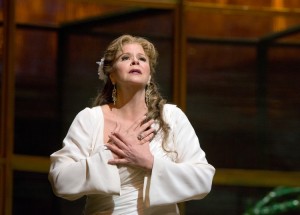The Metropolitan Opera’s online pay-per-view series, “Met Stars Live in Concert,” has been a boon during COVID-19 times. This past Saturday it was Joyce DiDonato’s turn, live from the Jahrhunderthalle in Bochum, Germany. I’ve been a fan of hers for years, and aside from her artistry, I appreciate her advocacy for arts education and especially her generosity in streaming an impromptu performance of Werther excerpts with Piotr Beczala from her living room during the early days of the pandemic shutdown. I had been looking forward to seeing the two of them perform this opera at the Met at the end of March, but hearing them in fabulous voice via streaming went a long way toward curing the disappointment of missing what would have been perfect casting.
So let’s turn to Saturday’s event. In all honesty I may run out of superlatives before the end of this blog post.
Accompanied by Carrie-Ann Matheson, pianist, a wonderfully sensitive musical partner, and members of Il Pomo D’Oro, a baroque ensemble with whom she frequently appears, Ms. DiDonato’s performance was less of a recital than a dramatic presentation. Focusing on themes of loss, joy in nature and love, the three sections of the program, titled “I Dream a World,”proved that the intelligence displayed in the selection of music amply matched the brilliance of performance.
I was somewhat surprised that Ms. DiDonato began with back-to-back farewell arias from Monteverdi and Berlioz operas. Usually a recital leads off with something upbeat, but these selections, especially Didon’s final scene from Les Troyens, rested entirely at the mournful end of the spectrum. However, her uncommonly bright sound certainly displayed the piece in its best light. These arias were an excellent prelude to what followed: “Ich bin der Welt abhanden gekommen” (“I am lost to the world”), the last song in Mahler’s Rückert-Lieder cycle, one of the most beautiful pieces of music I’ve ever heard. That Joyce, in her hushed delivery, did it justice is an understatement.
A lovely a capella rendition of the traditional “Oh Shenandoah” opened the next portion of the program. I especially enjoyed her insertion of a musical turn in the last chorus, highly reminiscent of Irish folk music (If I remember Robert McNeil’s “The Story of English” correctly, this is accurate, given the origins of the Appalachian settlers). The DiDonato touch was wonderfully in evidence for “Dopo notte atra e funesta,” a showstopper of an aria from Handel’s Ariodante in which she was accompanied by members of Il Pomo D’Oro. Prior to this recital I had heard her sing this aria on disk and in a live concert performance of the opera, yet each time the set of vocal embellishments was more complex. And it was so much fun to see her and the instrumentalists bopping along to the syncopation of the music.
The last section of the program opened with the world premiere of a new work, Kenyatta Hughes’ “I Dream a World,” with text by Langston Hughes (no relation), which gave its title to this recital. I enjoyed the reflective nature of the music—it underscored the powerful language and emotion of the poem to a fine degree. But it was what followed that turned out to be my favorite part of the program: a pairing of “Voi che sapete” from Le Nozze di Figaro and that evocative Edith Piaf chanson, “La vie en rose.” Joyce DiDonato is one of those singers whose pleasure in performing is so evident that she easily carries the audience along with her. You could sense her enjoyment in portraying Cherubino’s befuddlement in the Mozart aria, which she made sound incredibly fresh, as well as indulging in a more sophisticated mode with the French song. It was a welcome surprise that she programmed the latter—it was great to hear her display some jazz chops. Following a heartfelt pitch to her audience to write their elected officials to urge more funding for arts education, Ms. DiDonato then wrapped up with the haunting “Canción al árbol del olvido” by Alberto Ginastera and “You’ll Never Walk Alone” from the musical Carousel. So to sum up: Works in five languages spanning five centuries performed by an artist at the peak of her career. It never gets better than this. Thank you, Joyce, and brava!
This performance will be available on demand at metopera.org through September 25. Enjoy.



















